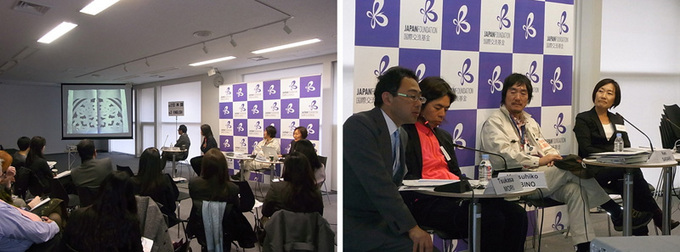"Having Tomorrow is a Blessing"--Healing Minamisanriku with Children's Songs
Yumi Yoshikawa
President, Daha Planning Work
The Kiriko project and the women of Minamisanriku in Miyagi Prefecture
The Kiriko project is a local community art project launched in 2010 with the support and participation of local women in the Shizugawa area of Minamisanriku town, Miyagi Prefecture, in northeast Japan. In setting up this project we were looking to breathe new life into the local shopping district and unearth some potential short-stop tourist destinations that would help boost local tourism.
The town of Minamisanriku has kept up the custom of decorating household altars with delicately cutout paper ornaments known as Kiriko. The paper cutouts are traditionally made by chief priests of local shrines, using a white sheet of paper which is folded in half and cut out in the shapes of various auspicious objects. The Kiriko project was inspired by these paper ornaments. The local women made Kiriko cutouts, 650 pieces in all, and decorated the homes and shops; they hung strings of cutouts on the eaves or across the entrance of buildings standing along a one-kilometer stretch of the main avenue, all the way from the railway station to Osakana Street. The cutouts were based on research done by the women, who went from door to door, asking residents to share memories and anecdotes about their cherished items or experiences. These stories were then summarized on sheets of paper and displayed in front of the homes alongside the Kiriko cutouts.
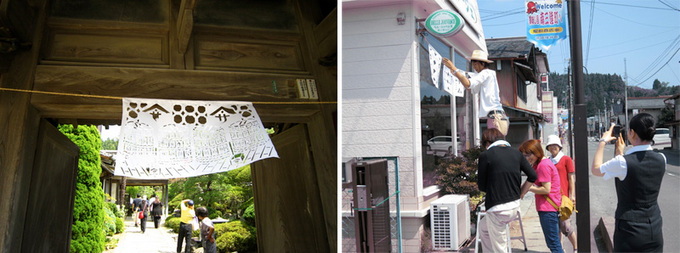
The art project "Kiriko Street" ran from late August to early September, 2010
There were so many stories. One was about a candy store operator who had his business destroyed by the 1960 Chilean tsunami. He struggled, earning money selling ice pops around the neighboring towns on his bicycle, and got his store up and running again. A caterer who has now closed shop reminisced about the good old days, when business was booming and lots of weddings took place. One person spoke about his old family home that had a warehouse where they would steam silkworm cocoons in hot water, while another shared a story about a well in the backyard of an old house of a family that used to run a soy sauce business and how it supplied fresh spring water. The Kiriko activity helped bring back long-buried memories, and the local people started communicating and getting to know each other once again. I was hopeful that visitors, too, would find it enriching to communicate with the local people who have these wonderful stories to share. The project proved very encouraging, demonstrating a potential for revitalizing the commercial district.
A growing number of women joined the project as it collaborated with the local government office for industry development, and our activities branched out in various directions. For instance, we called on foreign-born women--those who came to this town as wives from countries such as China, Taiwan and South Korea--and organized a craft workshop on the paper cutting art of their native countries. We also put together Asian Day, a cross-cultural food-tasting event. There was a course on the product display intended to make walking around town more interesting from the perspective of female visitors. The project also set out to create original sweets using local food.
A meeting was held on February 2, 2011, to report and discuss the Kiriko Project, attended by as many as 140 residents, including the town's mayor and the head of the tourism association. People rediscovered the community's local resources, and shared their appreciation and admiration for the women's achievements. The meeting ended a great success, with the residents of the neighboring Utatsu area expressing their wish to launch a Kiriko project of their own.
The day everything changed--"Sending our thoughts to the coast of Minamisanriku"
The great earthquake and tsunami that struck on March 11, 2011, wiped out the town of Minamisanriku in the space of about five minutes. The devastation was staggering, with 70% of the buildings washed away and not even a trace left of most of the public buildings, offices, plants, shops and houses.
With support and encouragement from non-profit arts organizations across Japan that are familiar with our work, we began our activities in the tsunami-stricken areas as early as March 22. Thousands of people were still missing, and local residents were immobilized, staying in shelters and waiting anxiously to learn the whereabouts of their missing family members. Understandably, the efforts to get the whole community to evacuate were stalling. In addition to the high levels of media attention, the affected areas were overwhelmed and distracted by various events and successive celebrity visits that kept the victims unsettled and unable to find any quiet time to sort out their minds, shed some tears, and mourn their losses with families and neighbors.
That is when a local government official approached us, looking for suggestions that might help the people take a step forward toward rebuilding their lives. So we organized a monthly meeting for the residents to get together and share a moment to reflect on their thoughts. The meeting, named "Sending our thoughts to the coast of Minamisanriku" was first held on May 11, 2011, and continued in the following months until September 11, the day of the town's memorial service. Musicians living in Sendai and members of the Sendai Philharmonic Orchestra came to play music at the sessions held on the 11th day of every month, and non-profit art organizations from all over Japan arranged a USTREAM broadcast for the out-of-town evacuees. On May 11, people staying at seven different evacuation shelters inside and outside the town were able to watch the meeting and the images of their hometown coast, streaming live on the screen. The people leaned forward, and tearfully watched the scenes of familiar people and places. Even if they were physically away from home, this meeting provided an opportunity for the residents to reunite, think of their hometown and grieve together.
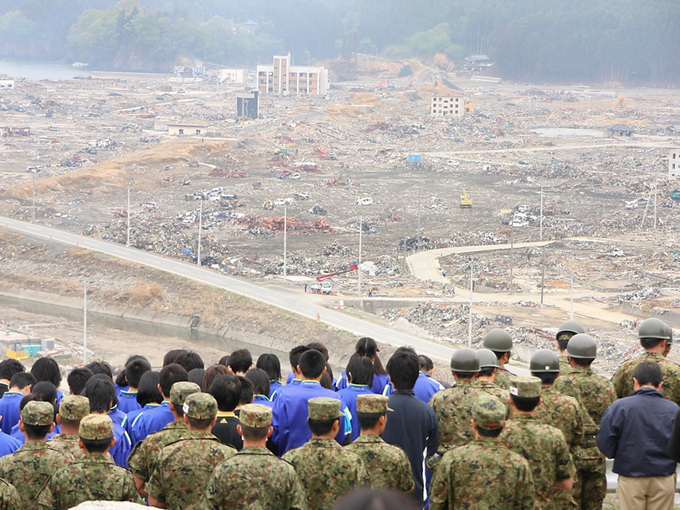
"Sending our thoughts to the coast of Minamisanriku" meeting on May 11, 2011
PHOTO: Saori Fukuda
Sadly, some of the women who worked on the Kiriko project have passed away. We have continued with our work, nevertheless, to help women find employment or start up a business using their own ideas. Our efforts have borne fruit and culminated in various initiatives and activities, including the Fukko Ichi, or "recovery market". This monthly market and the women's activities were highly praised, and on February 4, 2012, the town of Minamisanriku won the Regional Development Award grand prize presented by Minister of Internal Affairs and Communications. The network of Kiriko project participants continues to thrive to this day. Members get together from time to time to talk or develop new products. I believe that having shared the experience of working on the Kiriko project in 2010 made it possible for the women to find a source of strength in their friendship even in such difficult times.
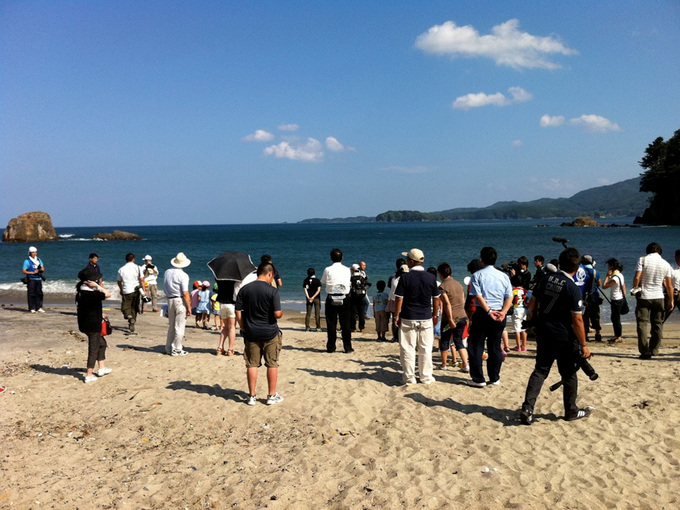
"Sending our thoughts to the coast of Minamisanriku" meeting on August 11, 2011
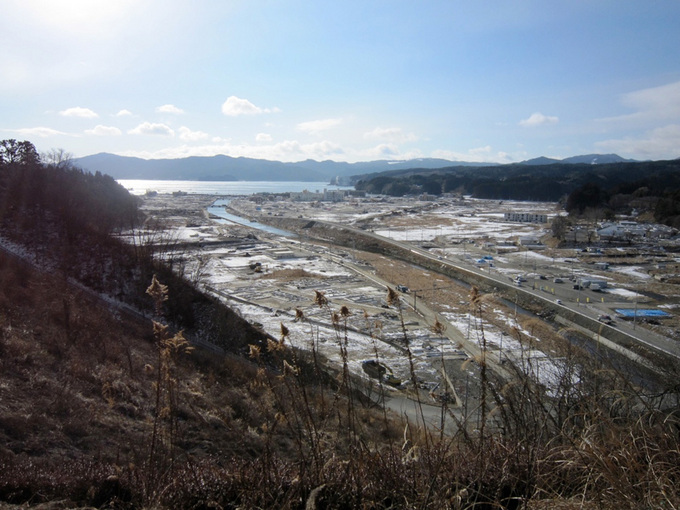
Shizugawa district, Minamisanriku in winter 2012
Let's get the children to sing at the memorial ceremony
Several months ahead of the memorial ceremony marking the first anniversary of the earthquake and tsunami on March 11, 2012, we launched a music project for elementary school children in Minamisanriku. The idea was to get a group of local children to create songs and perform them at the ceremony to cheer up the local people. A total of 135 children signed up for the project--fourteen fourth graders from Tokura Elementary School, 51 fourth graders from Shizugawa Elementary School, 32 third and fourth graders from Iriya Elementary School, 17 third and fourth graders from Natari Elementary School, and 21 fourth graders from Isatomae Elementary School.
Getting the project going was not a smooth undertaking, and we had to go through multiple rounds of discussions with the teachers before the music workshop could be held. The first issue of contention was whether it was suitable for children to attend a memorial ceremony. Some teachers questioned the wisdom of making them sit through a long ceremony, in an atmosphere which would be unusual by any measure, with the big altar, everyone dressed in black, and so on. Wouldn't they find it uncomfortable? So we consulted with school counselors and agreed that the children would not enter the hall until right before their performance. The concern was understandable given what the children had been through; in Tokura Elementary School, in particular, a student--a fourth grader on his way home-- and a teacher were killed during the tsunami. Those who escaped fled to a hilltop and spent the whole night in and around a small shrine there, surrounded by the deluge. Also the fourth-grade homeroom teacher had lost his/her father in Rikuzentakata, another badly damaged coastal city in Iwate Prefecture. The children suffered deep emotional scars, and just trying to fill out a questionnaire about the disaster was enough to make some of them sick. The teachers of the school that had suffered the greatest loss, however, were the most supportive of this project. Tokura's school principal and vice principal both suggested that taking part in the ceremony might very well help the students take the first step toward rising above the disaster.
Expressing themselves in their own words, in their own melody
Another debate concerned our approach to music education. Some teachers felt that getting the children to write a song was a bad idea; in their view, the audience would not be touched in any profound way unless the children sang a well-known song that people could relate to, like Furusato (Hometown), and sing it in perfect harmony, with lots of practice. Others wondered if the team could really write a song in just a couple of hours. We were also asked what the song would mean for the local residents and whether it had a chance of becoming the kind of song that people will enjoy singing in the years to come.
Despite doubts expressed by some teachers, we stood our ground on having the children express themselves in their own words and melody. There was no doubt in our minds that that is exactly what they needed to find the strength to overcome the disaster. A health and welfare official in charge of organizing the ceremony backed us up on this point, saying "The folks living in temporary housing are now going through tough times and some people are very depressed. The children's singing might just be what we need to lift up their spirits." After completing dozens of meetings with the teachers of each school in December 2011, we ran a series of two-hour workshops starting late January 2012. Two musicians based in Sendai that I had worked with on many other occasions, Mitsuhiro Sakakibara and Taishi Igari, conducted the sessions. I helped out with the lyric writing.
In Shizugawa Elementary School, the song-making took the form of having the children listen to heartbeats with a stethoscope and then using that rhythm to compose a melody. We took this approach because last year the children had the opportunity to attend a body percussion workshop by Rick Willett, a former member of the STOMP dance troupe.
In the remaining four schools, we started off with some games to get the children relaxed, then set to work. First we composed a melody. Each of the children had a piece of cardboard hung around his or her neck with a music note written on it. They played a game of switching places, and we jotted down the notes in the random order that the children were lined up. Just like that, we had a music score. The next task was writing a lyric to go with the melody. We asked the children to describe their feelings, thoughts and real life experiences on a range of subjects. They were happy to share their thoughts in their own words in response to my questions, such as "What are some things the local people and you yourselves have worked hard on since the disaster?", "Tell me about the little things that made you happy over the past year," and "Can you describe the best things about your town?" and so on. The children's words were turned into lyrics, arranged and adjusted to match the number of musical notes. Finally, the song was complete. The two musicians wrote accompanying music, which the Sendai City Symphony Orchestra offered to play on the day of the ceremony. With the effect of an orchestra back-up, each song became a dramatic and powerful piece of music. The children's raw accounts went straight into the song. There was a story about the children helping to carry boxes of relief supplies and fetching water; a story about adults rebuilding their shops despite having lost their house, their business, and everything; a story about a fisherman going out to sea to bring back a boat that had been carried away by the tsunami and loading it with seeds of sea squirts, oysters and seaweed.
Our biggest concern was Tokura Elementary School, but we needn't have worried. During the workshop, one child remarked that he evacuated with a friend and felt happy when they were able to eat a meal together. Suddenly, one child after another burst out talking, recounting their moments of happiness: "I was happy when I was reunited with my family," "I was happy when the lights went on," and so on. Just imagine: these are fourth graders that had lost a classmate; the teacher who had lost a father and a grandfather. When we wrapped up the session we left the lyric unfinished because we wanted a classmate who could not be with us on the day of the workshop to complete the last two verses. The child was in hospital in Morioka, Iwate Prefecture, with a serious illness. When we asked what a moment of happiness is, the child responded, without hesitation: "Having tomorrow is what makes me happy," and surprised even the child's mother. Thinking of all those 20,000 or so people who should still be alive and well today, but are not, the homeroom teacher completed the last two lines with "Having each other is a blessing. Having tomorrow is a blessing."
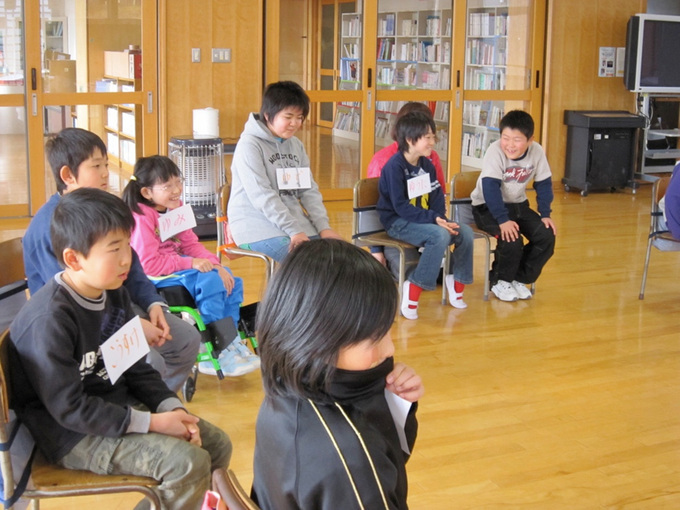
"Making our future into a song" workshop at Natari Elementary School
The voices echoed through the arena
The children of all five schools met each other for the first time on the day of the ceremony. They rehearsed with the orchestra one last time. The first thing the children did as they arrived at the hall was to put their hands together in prayer in front of the large altar decorated with flowers. Earlier, I had suggested to the teachers that we let the children do this, and they had all agreed. School by school, the children approached the altar and quietly paid their respects. No one moved until we told them it was time. I could tell that in their own way the children truly appreciated the consequences of the events of March 11, 2011.
When it was time for the children to sing, their songs reminded the audience of each and every detail of the things they had gone through in the past year. The performance allowed the approximately 3,000 audience members to picture in their minds their once beautiful town and the people who were working together to rebuild their lives, refusing to give up in the face of hardship. In the middle of the song performed by Isatomae Elementary School, there is a part where the children would repeat "we all worked together" three times in a marvelous chorus. By the third time their voices were so loud they resonated within the bodies of the audience in the huge arena. At this moment, no one could suppress their tears anymore; everyone was crying. The faces of the staff members were also streaked with tears.
After the ceremony, I happened to hear an old man being interviewed by a TV reporter. He said, "It's time I stopped moping. Even the kids are fighting to move on." We had worked hard with the students and teachers in the hope that the performance would help as many people as possible feel encouraged as they placed a flower on the altar, and help heal their sadness and pain in any small way. And what this old man just said couldn't have been more rewarding. In fact I have actually noticed considerable signs of change for the better in this town since the memorial ceremony. We received wonderful responses from people who heard the children's songs over the radio broadcast in the shopping district. The mayor and the guests all cried when they heard the songs. The young children evidently succeeded in inspiring and motivating even the town leaders.
Around the time of the one-year anniversary, the video images of the tsunami were once again all over television. The images made some of the Tokura students feel ill, but I learned that none of the children who took part in our workshop were affected. The experience of communicating their thoughts using their own words and melody did not just help heal the adults; it also helped the children draw strength to overcome their painful memories. My own experience in the project led me to believe that taking initiatives and getting involved in creative and expressive activities can enhance the emotional well-being of disaster victims. Although the project did generate some controversy in the planning stage, the outcome was worth all the effort. The teachers, the public officials, the mayor, the community leaders and the staff are all thrilled with the project's success. Using this experience as a stepping stone, I look forward to continuing my work creating opportunities for people to get together, express their feelings, share memories and reinforce their sense of pride at schools that are the cornerstone of every community.
This article is based on the presentation made by Yumi Yoshikawa at the Cultural Meeting Points - Spring Seminar 2012, held on March 26, 2012, at the Japan Foundation Information Center. The seminar, hosted by the Japan Foundation, is held periodically and aims to provide opportunities for foreign embassy officials who are in charge of cultural affairs to gain a deeper appreciation of the latest trends and developments in the Japanese art scene. A number of leading professionals from a variety of fields are invited to speak at each session. The other speakers on March 26, 2012, were Katsuhiko Hibino, artist, Tsukasa Mori, director of Tokyo Artpoint Project, and Ken Sasaki, a town government official in charge of lifelong learning in Otsuchi, Miyagi Prefecture. They talked about the various community rebuilding activities carried out by cultural exchange organizations based in the Tohoku region.
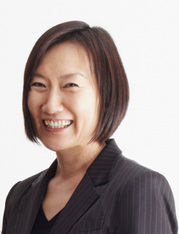 Yumi Yoshikawa
Yumi Yoshikawa
Resident of Miyagi Prefecture. Director, Culture and Creation Project, Hachinohe Portal Museum "hacchi." Part-time lecturer at the School of Project Design, Miyagi University. President of DAHA Planning Work and envisi. Yoshikawa writes, directs and produces various events such as concerts and theaters, and gives management advice to cultural halls located across Japan.
Related Events
Back Issues
- 2024.10.25 From Study Abroad in…
- 2024.5. 2 People-to-People Exc…
- 2022.11. 1 Inner Diversity<3> <…
- 2022.9. 5 Report on the India-…
- 2022.6.24 The 48th Japan Found…
- 2022.6. 7 Beyond Disasters - …
- 2021.3.10 Crossing Borders, En…
- 2020.7.17 A Millennium of Japa…
- 2020.3.23 A Historian Interpre…
- 2019.11.19 Dialogue Driven by S…


